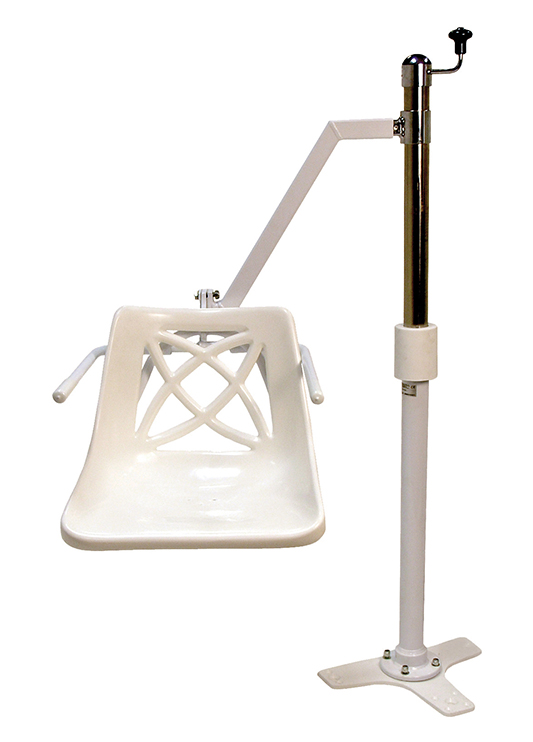
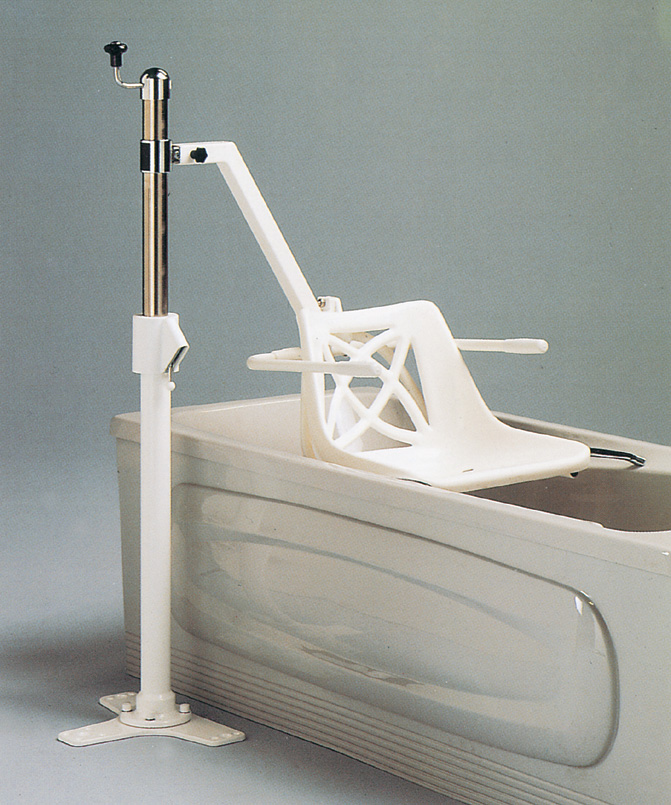
Floor-fixed manual bath hoist. Options include: side or end fit configurations; standard seat, commode seat or Ranger Transporter option. Accessories: lap strap.
Multicare Medical Ltd
Active Mobility Centre Ltd
Vivid.Care
Oxford Healthcare
Easy Care Systems Ltd
Essential Aids (essentialaids.com) Ltd
Manufacturer's Product Description
The Oxford Mermaid is a fixed bath-side hoist that enables patients to safely and easily transfer in and out of the bath. With a choice of configurations and fixing options, the Mermaid is suitable for the majority of bath-side locations. - Safe working load 125kg / 20st / 276lbs - Wooden and concrete floor fixings supplied as standard - Choice of electric or manual options - Optional side or end fit configuration - Choice of fixed seat or Ranger Transporter system - Lap strap for patient safety - Optional safety harness for added security - Emergency stop/emergency raise (electric model only) - Detachable battery pack (electric model only) - Electric retro-fit kit available
Manufacturer's Contact Details
https://oxfordhealthcare.co.uk/
Oxford Healthcare
Drakes Broughton Business Park
Worcester Road
Drakes Broughton
Pershore
Worcestershire
WR10 2AG
United Kingdom
0344 811 1158 info@oxfordhealthcare.co.ukDownload manuals
Key Features
- plastic shell seat
- winding handle
- wooden and concrete floor fixings
Product Dimensions
| Dimensions | |
|---|---|
| Capacity | 125kg |
| Seat | |
| Seat depth | 41cm |
| Seat width | 40-45cm |
Product Specification
No product specification has been specified.
Introduction
Most of us enjoy a relaxing soak in the bath and may feel frustrated if this pleasure is taken away. It may become difficult to get in or out of the bath, or the bathroom itself may become inaccessible, particularly if it is upstairs. In most cases these difficulties can be overcome by using one or more of the many items of bathing equipment currently available, and/or by making alterations to the house.
Installing equipment in your bath
You will need to ensure that your bath is strong enough, of the right dimensions, and safe for the installation of bathing equipment.
You will need to consider:
The length of the bath
Check whether the bath is long enough to use the equipment - especially if a bath board and seat combination is going to be used, and if you will want to straighten your legs in the bath, or if you are particularly tall. A 1700mm long bath allows room for most bath equipment.
The width of the bath
If the bath is exceptionally wide or narrow, standard equipment may not fit into/on it.
Built-in grab rails on the side of the bath.
The positioning of these may hinder the use of equipment or entry and exit to the bath. The side flaps of some bath lifts can become stuck under the built-in grab rails. Some bath lifts come with sliders that fit to the grab rails and prevent the flaps getting caught.
The material of the bath
Metal baths are strong enough to withstand most types of bathing equipment. Most acrylic baths are not strong enough to take wedge-in bath seats and, when free-standing bath seats and removable bath lifts are used, the weight should be distributed over as wide a base as possible. You should always check with the supplier of any bathing equipment if there are any limitations on the kind of bath they can be used in, and if necessary check with the manufacturer of your bath. If you are unsure what your bath is made of, see if a fridge magnet sticks to the side of the inside of the bath. If it does, it is probably made of enamelled metal. If the bath sounds like plastic when you tap it, then it is probably plastic/acrylic.
Corner baths
Only a few items of equipment can be used in a corner bath, such as specific bath lifts and bath seats (check online product descriptions to see if they mention corner baths or contact the suppliers). Remap (a national charity that helps disabled people achieve independence and a better quality of life by designing and making equipment for their individual needs) may be able to build a bath board for a corner bath.
Equipment to help you to get yourself in/out of the bath
To use bath boards and seats you will require reasonable grip and muscle strength to transfer on and off the board/seat. You should be able to maintain your balance whilst sitting and be able to bend at an angle of 90° at the hips. You will need to be able to bend further forwards if you wish to reach the bath controls or wash your lower limbs/feet without using a long handled sponge
Bath boards
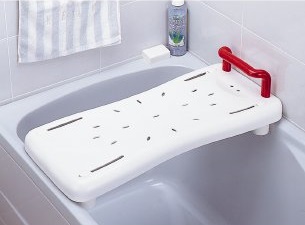
Bath boards are waterproof boards that fit across the top of the bath (the opposite end to the taps) to provide a secured area on which to sit. They are often combined with bath seats. Once seated on the board you can support yourself on the bath sides to lower yourself down onto a lower bath seat.
Some boards are designed with integral handgrips which may be useful when moving onto and off the board. Some boards have a cut-away section or a dip at the front to make personal cleaning easier.
The board may be perforated or slatted, so that water drains away easily, and can be made of different materials, such as solid or padded plastic, wood, metal or cork. In general, padded boards or seats will provide greater comfort and feel less cold.
Slatted or perforated boards will allow the water to drain away quickly, so that drying is easier and the board is less slippery to sit on. However, ensure that the holes are small as it has been known for male users to trap certain body parts.
Bath boards may sometimes also be called shower boards. Shower boards have greater width/depth than bath boards providing a greater area of support whilst sitting under a shower, whereas bath boards are narrower to provide more room if you wish to transfer down onto a bath seat. Bath boards can be used to sit on whilst showering.
Bath boards are available in different lengths. To get the right length, measure across the width of your bath, including the bath rims. If the board is too long it will stick out over the side of the bath and there is a chance it could tip up if you sit on the end. If the board is too short it will not have sufficient support.
The board must fit securely across the top of the bath. All have an adjustable fixing system, usually brackets on the underside, which braces the board against the sides of the bath. The angle of some brackets can also be altered to wedge the board against the inside rims of the bath. These should be checked on a regular basis, especially if the board is regularly removed for others to use the bath. The brackets are usually made of plastic and some may be held in position with wing nuts which people with weak or painful hands may find difficult to tighten. The brackets usually have slip-resistant covers to provide extra grip and to prevent marking the bath. These should be checked periodically as they may wear after long-term use.
Bath boards may not fit baths with irregular shaped sides, corner tiling etc. If this is a problem then a wall-mounted bath board may be an option.
Before purchasing a bath board check that the rims of your bath are level and at the same height on both sides of the bath and that the width of the bath rim is at least 25mm on each side of the bath.
To transfer into the bath you reverse towards the board and sit down on it before swinging your legs over the edge to place them on the floor of the bath. It is strongly advised to have grab rails fitted to the wall to hold whilst completing the transfer. Some people find it difficult to lift their legs over the bath rim whilst seated, but this can be helped by using a leg lifter.
Wall-mounted bath boards
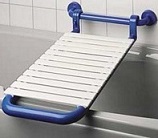
These are mounted to the wall beside the bath and can fold up against the wall when not in use.
They provide a seated area over the bath which can provide a safe method of transfer in/out of the bath.
Some users prefer the fact that wall-mounted bath boards are secured in place and not subject to 'user error' when being refitted.
Bath transfer benches
A transfer bench is a four legged seat which spans over the outer edge of the bath. They usually have a back rest and a single arm/handle on the end inside the bath.
They are used in the same way as a shower/bath board, by reversing towards the bench, sitting down and swinging your legs over the edge to place them on the floor of the bath. Some people may find it easier to use than a board and it offers more support.
A transfer bench does not require support on the bath rim on the far side of the bath, so may be useful when this is not available.
Bath seats
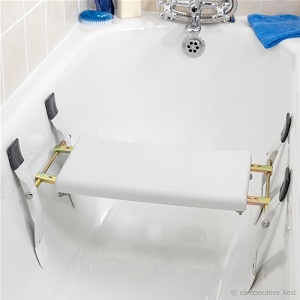
Bath seats are often used in combination with a bath board. It provides a lower sitting platform between the bath board and bottom of the bath. It positions you nearer to, or in, the water. Bathing from the seat still means you will not experience the relaxation of lying in deep water or stretching out in the bath. If you have long legs or a short bath then you may find your knees have to remain bent when seated on the board. Good upper body strength is needed to move yourself between the seat and the board.
Bath seats are sometimes used on their own, without a bath board. You need to be able to step safely into the bath and position yourself onto the seat. After bathing you will need the strength to push yourself up to standing from the seat.
If more able, you may choose to use the bath board and seat to move down, step by step, into the bath. The board and seat can then be removed by a carer, to allow you to stretch out in the bath. Significant effort is required to reverse the process to get out of the bath.
Bath seats are available with backrests and/or armrests and come in different heights. The shorter the height the lower down in the water you sit, but the more effort will be required to stand up from the seat. It is recommended that bath seats are used in conjunction with a slip-resistant bath mat.
Please note: When you install a seat or stool into a bath, you must ensure that the bath is designed to support the weight of a seated person, concentrated through the legs/brackets of the stool/seat, otherwise the bath may crack. If you have an acrylic bath you are advised to consult the bath's manufacturers or suppliers.
There are three types of bath seat:
Suspended seats
These hang down from a framework which rests on the bath rim. The width of the frame can be adjusted to fit different sized baths. The ends of the frame are covered in a slip-resistant material to provide extra grip and to prevent damage to the bath. They can generally be used in metal or acrylic baths. Some have a backrest which gives full support but makes them difficult or impossible to use with a bath board.
Wedge seats
Wedge seats often have four hinged paddles which are attached to the metal seat frame and wedge firmly against the sides of the bath. The frame can be adjusted to ensure a firm grip against the bath sides. Most are only suitable for use in metal baths - some plastic or glass fibre baths may crack as the legs push against the sides of the bath.
Free-standing bath seats
These have feet or suction pads which stand on the bottom of the bath. Some have adjustable side brackets which can be tightened to wedge against the side of the bath, reducing seat movement and providing the user with extra stability. They can generally be used in all baths, although those with larger bases to their legs are more suitable in acrylic baths than those with narrow legs as the weight is spread over a larger surface area.
Some bath seats have backrests, although these provide varying amounts of support. You are advised to check whether the model has a backrest or not. A high backrest will provide much more support than a low one, but if it protrudes above the bath rims the seat cannot be used in conjunction with a bath board. Padded backrests will provide more comfort if you are thin or in pain. Some seats have a cut-out section at the front to make personal cleaning easier. The term 'bath seat' is often used for bath stools.
Combination boards and seats
These consist of a bath board attached to a bath seat and have the advantage of being more stable than two separate units. However, they can be rather bulky and heavy to remove from the bath.
Swivel bath seats
Swivel bath seats fit over the bath and swivel to aid transfers over the bath. These seats have a back support and armrests. Most have a lever to lock the swivel mechanism in place whilst you are sitting down on the seat and when over the bath. These seats do not lower you into the bath.
Leg lifters
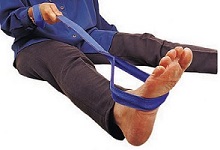
If you have difficulty lifting your legs over the bath rim when using a bath board or swivel chair, a leg lifter may help.
Manual leg lifters consist of a reinforced strap with a loop on the end. You hook your foot through the loop and then, with your arms, physically lift the loop (and thereby your leg) up to the edge of the bath rim and then down into the bath.
Grab rails
Grab rails will give you secure anchor points with which to steady or manoeuvre yourself. Grab rails in a bathroom should have a ribbed or textured surface to give extra grip when wet.
Horizontal and inclined rails
When standing from a sitting position in the bath you may find it helpful to hold one horizontal wall-fixed grab rail (placed above the bath) with one hand and use the outer rim of the bath with the other hand to push against. There needs to be a 50-60mm clearance between the wall and all handrails.
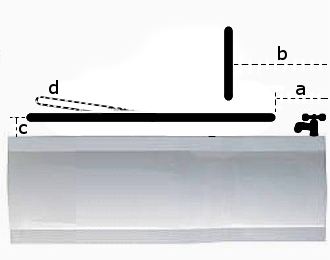
A rail can be fixed horizontally to the wall 75-100mm above the bath rim (see dimension c in diagram). It should start 200mm from the tap end of the bath (dimension a).
Part of the rail can be fixed at an angle of 13 degrees upwards towards the head end of the bath to provide an inclined support.
The horizontal rail can be used in combination with a bath board. The user may benefit from holding the rail while they sit on the board, then turn and lift their legs in/out of the bath.
Vertical rails
When stood in the bath: A rail (at least 500mm long) can be fixed vertically on the wall, 600mm from the tap end of the bath (dimension b in above diagram), with its lower end 200mm above the bath rim. This is most likely to be of use when stood in the bath (perhaps whilst showering) or when standing up from a bath board.
Transferring into the bath: A rail which attaches to both the floor and the ceiling on the outer edge of the bath may provide support when the person is turning round to step in or out of the bath. It is recommended that it should be sited 400mm from the tap end of the bath where it can be reached from a sitting position in the bath. However, its position is likely to be in the way of someone using a bath board, or bath transfer bench, when they swing their legs in/out of the bath. These rails should be fitted by experienced installers, as they take a lot of weight and ceiling fixation can be complicated.
Bath side rails
These rails can provide a handhold to assist you up from the bottom of the bath or from a bath seat, and can help you to step into the bath. However, they will make it difficult to transfer your legs into the bath whilst seated on a bath board.
Floor-mounted
These are screwed to the floor and also clamp onto the side of the bath. They can be adjusted to the thickness of the bath sides and some models are adjustable in height. A vertical loop projects above the bath's sidewall and is held when stepping in/out of the bath. The fixings need to be checked on a regular basis and tightened when necessary.
Bath-mounted
These only clamp onto the side of the bath and can be adjusted to the thickness of the bath sides. Some models are adjustable in height. As with the floor mounted bath side rails, a vertical loop projects above the sidewall.
As these rails attach solely to the bath itself, great care needs to be taken to ensure that the fixing mechanism - usually a screw system - remains secure. This needs to be checked on a regular basis and tightened when necessary. They are not recommended for attaching to a plastic/acrylic bath as there is a possibility that the surface may crack.
If possible, rails should be both bath- and floor-fixed for full stability.
Cross-bath rails
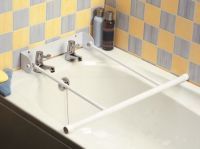
These fix to the wall behind the taps and rest on the bath rims. When sitting in the bath, the rail will be directly in front of you at about chest height. In this position it will provide stability whilst in the bath. The rail should only have downward pressure applied so the weight is taken by the bath rim; it is not designed for you to pull on to sit down or stand up from the base of the bath (Pain et al 2003).
Ensure that the wall is strong enough to take the weight of this type of rail. Care should be taken that you never bend down underneath the rail (e.g. to reach your feet) when sat in the bath as you could trap your head under the rail.
Tap-fixed rails
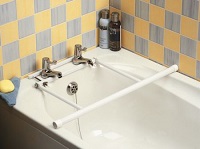
These also rest on the bath rims, but clamp around the bath taps and are therefore only as strong as the tap fixtures. Taps are not designed to withstand a full body weight pulling against them. The rail should only have downward pressure applied so the weight is taken by the bath rim - it is not designed for you to pull on to sit down or stand up from the base of the bath (Pain et al 2003). These rails fold down to rest on the bath rim and can be folded up against the wall when not required.
Equipment to provide more assistance to get in/out of the bath
Bath lifts
If you find it difficult to use a bath board or seat to move yourself up and down from the bottom of the bath, you may wish to try out a bath lift. The vast majority are powered and can be operated either by yourself, for independent bathing, or by a carer. (For carers, bath lifts may help to make the task of assisting someone easier and safer, thus reducing the risk of back injury.) Although expensive, a bath lift may be more cost-effective than installing a special bath or shower.
If you experience difficulty lifting your legs over the bath rim when in a seated position, some bath lifts can be raised higher than the top of the bath rims, which reduces how far you need to raise your legs to clear the bath rim.
Removable bath lifts
These fit inside the bath and can lift you from near the bottom of the bath (approx 80mm) up to the height of the bath rim. You must however still be able to lift your legs over the bath rim if you wish to bathe independently. The majority of bath lifts have a seat and backrest unit made of either solid plastic or mesh fabric, and some have the option of a reclining mechanism to give a more relaxing bath. Some bath lifts do not provide back support. These are not safe for use unless you have very good core stability and strength.
Most seats have side flaps which drop down and rest on the rims on the bath to assist with getting on and off the seat. Some models have a swivelling seat or disc on the seat which helps the person to get on and off. Alternatively, a flexible transfer disc can be placed on top of the seat to provide a means of swivelling.
You will need to ensure that the bath lift of your choice raises to the height of the edge of your particular bath, to provide a smooth transfer over the rim of your bath. Some have adapters that can be added when used in deep baths - check with the supplier.
These bath lifts can be removed for relocation or to allow another member of the family to use the bath. However, their weight and the rubber suction pads can make them difficult to remove. Some models have detachable components making the bath lift easier and safer to handle.
Bath lifts can be powered in a number of ways.
Motor driven
These use a rechargeable battery to power the lifting motor. The battery must be recharged regularly. Some have a safety system which will not allow the seat to lower to the bottom of the bath if there is not enough remaining battery power to raise the seat fully to the top again. Some have an emergency stop mechanism.
Powered lifts are controlled by a handset which is waterproof and is safe if accidentally immersed in the water. Some handsets can be attached to the side of the bath with suckers so that they are always conveniently positioned. Most handsets have press buttons to control the movement. Some are marked so that they can be used by a bather with sight loss. Rocker or toggle switches are sometimes available and are particularly helpful for a person with weak or painful hands.
As chargers have to be plugged into the mains this activity should be carried out away from the bathroom. On some models the handset only has to be removed and plugged into the charger; others have large batteries which have to be removed for charging. Some chargers can be used with non-British power sources.
Manual/hydraulic
Manual bath lifts are operated hydraulically, using the weight of the person to lower the lift and the buoyancy of the water to help to raise the lift. When you are ready to get out of the bath, you sit upright and push down on the bath rims. This releases the hydraulic piston, which is pre-set for your weight.
The effort of you pushing down, the hydraulic piston and the water buoyancy is enough to raise you up to the rim of the bath. You would need arm strength and flexibility, plus good core stability and strength, to use a hydraulic bath.
Inflatable
These are inflatable cushions, inflated using an electric pump. You may find the seat unit on an inflatable bath lift less stable, particularly if it has no backrest. They may not be appropriate if you have difficulty with your balance.
NB - For any type of bath lift, check its weight capacity, particularly if you are a large person.
Wall/floor-fixed bath lifts
These bath lifts are also called band lifts.
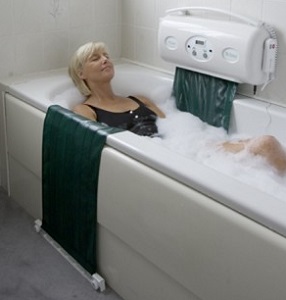
They consist of a fabric band on a roller connected to the wall. The band pulls out, runs across the bath rim and slots into a floor-mounted bracket. A battery or mains powered motor gently rotates the roller 'letting out' the band, lowering you into the bath. The roller is rotated in the reverse direction to lift you up.
Their advantage is that they lower you right down to the bottom of the bath and give you the freedom to lie back and soak.
These lifts are not suitable for everyone as they provide no trunk or back support, and you must adjust your position on the band at intervals during ascent and descent to keep yourself central. Thus you need to have good sitting balance in order to use these lifts safely.
Bath hoists
A hoist is usually a strong metal frame which may be static (fixed) or mobile. The frame has a lifting mechanism operated manually or powered by electricity. From the frame, or lifting arm/boom, is suspended a sling (on a spreader bar) or a chair, to support and carry a person as they are moved from one place or position to another.
Bath hoists fully support you as the user as they mechanically lift/lower you in/out of the bath. They will usually require the assistance of a carer. Please be aware that there are certain legal health and safety requirements regarding the use of hoists, especially if you employ a private carer. For more information see our factsheet on Selecting a hoist and slings for lifting a person.
Floor-fixed bath hoists
Floor-fixed bath hoists have a strong metal vertical column which usually slots into a base plate at the side or end of the bath. This has a seat or slings which pivot from the frame and can be raised or lowered. When raised it clears the bath rim and is lowered down into the bath.
The hoist usually lifts a rigid plastic bath chair with simple arm rests/bars which raise and lower each side. On some models the seat is detachable from the hoist and will fit onto a mobile chassis frame once out of the bath, allowing the person to be wheeled from the bathroom. The chassis may also be designed to allow the seat to be positioned over a toilet.
The hoisting mechanism may be manual or electronically powered, controlled with a remote handset. Manual hoists are operated by a winding handle designed to be operated by a carer. Powered hoists most often use a rechargeable battery which will need charging regularly. You operate the controls independently via a handset.
Hoists which provide a sling support
Although a few of the floor-fixed bath hoists have the option of using slings, most people who need the additional support gained from a sling will use a mobile or ceiling track hoist. It is better to use mesh slings in the bath as they allow the water to drain away easily.
A small mobile hoist can be used for many handling tasks in and around the home. However, if you need to be moved from one place to another, it is better to use an overhead track hoist or a sanichair. A mobile hoist can be heavy and difficult to manoeuvre, especially in confined spaces such as bathrooms, and the occupant can feel particularly vulnerable in transit. The hoist legs must fit under the bath to position the bather. This will require a minimum space of 11cm under the bath and the side panel will need to be removed or have a hole cut into it. Storage space for the hoist also needs to be considered.
Battery powered hoists are easier to operate than manual hoists as the motor takes the person's weight, but the battery needs to be charged regularly.
A ceiling track hoist is a permanent installation into a home, or other environment, which allows a service user, held in a sling, to be moved along a single or network of tracks between locations. It may be possible to create a track which allows you to move in the sling from the bed to the bathroom, where you can use the toilet and the bath or shower. It is more expensive to install, but it requires less space and less effort from the carer.
Ceiling track hoists provide a powered lift of the service user, but may then be powered or manually moved between locations (traversed). The motor is usually at track height. In order to charge it has to be moved to a charging station when not in use.
A structural survey is always required before a ceiling track hoist can be installed. Structural alterations may be necessary to enable the installation, such as strengthening the ceiling, or adapting the top of the doorframe to take the track.
Alternative baths
When planning to replace a bath consider:
- the space available
- the level of disruption in terms of both noise and mess whilst work is in progress, and the time the bathroom will be out of action
- the volume of water required to fill the new bath and compare this to the capacity of the current bath. Does the hot water tank have sufficient capacity?
- the aftercare of the equipment, particularly servicing and maintenance if the bath has moving parts
- the long term prospects. If your ability is likely to deteriorate a level access shower might be a better option
- other household members.
Depending on the kind and design of the alternative bath, you are advised to consider the need for installing additional grab rails.
Baths with a transfer mechanism
Baths are available which incorporate an integral swivel seat that lifts you up, over and down into the bath. The seat may include a leg raising mechanism to lift your feet over the bath rim. Most have a moulded seat, limiting your ability to recline.
When the seat has been raised above the bath rim, it can be swivelled outwards, either manually or automatically, for easier transfers. The height of the seat edge is important, especially if you need to brace your knees in order to stand upright, or need a level transfer from a wheelchair seat. A few systems have the facility to raise and lower the seat outside the bath.
The lifting mechanism is either manual or mains powered, controlled by the bather or a carer using a handset.
Walk-in baths
These baths have a door in the side or front that you can step through to walk into/out of the bath. Although there are no high sides to negotiate, there is a low step beneath the door. Full length baths with a door are available, but will then require you to be able to sit down/get up from the bottom of the
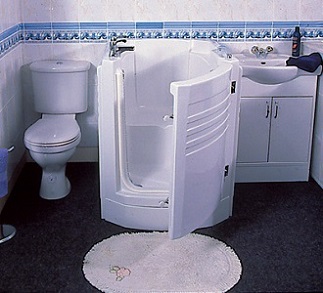
bath. A bath board and seat might also be required.
Walk in baths are also available with an integral seat moulded into the shape. These tend to be shorter in length, therefore reducing legroom, and may well be too cramped if you experience stiffness in the hips and knees. Those that are square take up less room in the bathroom, but if the door is outward opening, space will be needed to accommodate the swing.
The bath has to be empty before you enter it and then filled when you close the door. When exiting, the water needs to be drained before you open the door. This filling and drainage causes a delay during which you may become chilled, so consider keeping the bathroom well heated during use.
Check the height of the internal seat to make sure you are able to lower yourself down and stand up from it with ease. The moulded seat is supportive, but will limit your ability to recline. If you are unsteady on your feet, make sure the taps, plug and door controls can be reached from the seated position if you plan to bathe independently.
Shallow baths
The bottom of a shallow bath is higher than a standard bath. This may make it easier for you to negotiate getting in and out.
Baths with a built in seat
These baths have a seat built into the moulding of the bath so that you do not have to sit on the bottom of the bath. They have no transfer system and, like a bath seat, you must have fairly strong arms to lift yourself up and down. Many have cut away sides and a small corner ledge for you to perch on whilst transferring your legs into the bath.
Height-adjustable bath/shower trolleys
These combined function pieces of equipment provide a height-adjustable platform with sides which can be raised and lowered. With the sides lowered they can be used as a drying or changing platform, raised they can be used for showering and with the sides in the highest position they can function as a shallow bath.
Adjustable height baths
The height of these baths can be adjusted, either mechanically or electrically. This is designed to reduce the need for a carer to bend over the bath if you require assistance.
You may be able to step into the bath at its lowest level and then be raised to a convenient height. However, remember that the water usually needs to drain away before you can get out. These baths are not often used in a domestic setting.
Height adjustable tilting baths
In these designs, the concept of a height adjustable bath has been combined with the benefits of a step-in bath. The interior of the bath is moulded to provide a supportive, reclined seated position. It also has a swing-up side panel. The whole bath is able to tilt forward, bringing the moulded seat into an upright position. With the side panel lifted, you are able to transfer sideways into the bath. Once the side is lowered, the bath can be tilted back, putting you in a reclined position.
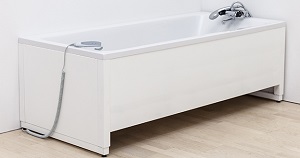
As with a walk in bath, the bath can only be filled once the user is in the bath and must be drained before they leave the bath, giving a time period when they may possibly get chilled.
Support, comfort and positioning in the bath
Care must be taken when using any bath cushion or insert that they will not slip accidentally. Check all fixing mechanisms regularly and replace when they are looking worn or broken.
Cushions for comfort
Plastic covered foam cushions can be used to line the bath to make someone who is frail more comfortable, or to increase your safety if you have involuntary movements. Shaped cushion inserts are also available for some of the moulded plastic bath seats and lifts.
Mouldable body supports
These are large waterproof, mouldable cushions which are filled with polystyrene beads. They are available in different shapes to support various parts of the body. They will conform to your shape - this shape can be semi-permanently fixed when the air inside is removed using a pump. They are secured to the side of the bath with suckers.
Head supports
Head cushions improve comfort when lying back in the bath. They are fixed to the bath with suction pads.
Pressure relief cushions
If you require pressure care, it should be provided in all daily living activities, i.e. not only as a pressure cushion for the wheelchair, but also in bed, in the bath and on the commode or toilet. Bath cushions should have a waterproof outer cover and a heavy inner substance which enables the cushion to remain submerged.
Other useful bathing equipment
Water level Indicators
These emit an audible warning when in contact with water and can therefore be used to alert you when the bath is full. This can be particularly useful if you have short-term memory loss or low vision.
Bath mats and slip resistant materials
Mats which are secured with suckers to the bottom of the bath, self-adhesive strips and spray-on slip-resistant material will all help to reduce the risk from slipping in a wet bath. Before every use the mat should be checked to ensure it is securely fixed.
Bath steps
Bath steps provide a step-like platform on the outside of the bath, lessening the height you need to lift your legs to get into the bath.
However, they are not suitable for people who have difficulty keeping their balance, and they will not help you to lift your legs out from a deep bath.
If used, a slip-resistant step provides a safer surface to stand on, and a grab rail mounted on the wall may provide a secure handhold to grip whilst using the step.
Tap turners
If you experience difficulty turning your taps on and/or off due to a weak or painful grip, you may wish to consider trying tap turners. These fit onto the top of your existing taps. Most are designed for a particular type of tap (e.g. for cross or bar head taps or for round heads). They are usually colour coded red or blue for hot and cold taps.
Alternatively you could replace your taps with lever taps. These are easier to turn as the lever can be pushed/pulled to operate the tap. On most the lever only needs to turn a quarter of the way around the tap to go from off to fully on.
Bath taps should not be used as a support to pull up on when getting out of the bath - most will not be strong enough to withstand a person’s weight. Strategically positioned grab rails should be used instead.
Long handled bathing aids
There are long handled washing and personal care equipment and hand and foot care aids available, designed to help make it easier to reach parts of your body when washing with less stretching or bending.
This equipment can be used for washing your feet, back or other hard to reach areas of the body such as between the toes. It may be best to use this equipment whilst seated in your bath, to help avoid any potential difficulty with your balance when reaching with the equipment.
Assessing your needs
There are a number of factors about yourself to consider in order to identify the most helpful bathing equipment for you. For example, how able you are to:
- mobilise (walk or propel yourself in a wheelchair)
- transfer (moving your body from one location or surface to another)
- maintain your balance, whilst sitting and standing
- grip with your hands
- lift your body weight through your arms and hands
- wash and dry yourself.
For most people the primary difficulty in bathing is actually getting in and out of the bath (bath transfers), especially lowering themselves down into the bath and then lifting themselves out again. This requires a significant amount of grip and muscle strength in the upper limbs and core strength in the body. There is a range of equipment available which aims to make bath transfers easier, breaking the process into easier steps, whilst providing support and security. If this is not sufficient, equipment is also available which does the lifting in and out for you.
Equipment is always supplied with an identified weight limit. If you are a particularly large person, you are advised to weigh yourself accurately and check each piece of equipment. You can then ensure that anything you buy, or with which you are supplied, is suitable and safe for you.
If mobility and transfers are difficult for you, you may need to consider changing your environment, adapting or building a bathroom which will meet your needs, or installing equipment that will help you and a carer if you require one. This is a potentially intrusive and stressful experience, but if well planned, could provide you with a long-lasting solution. If you are planning a new purpose-built accessible bathroom, be aware of the requirements of building regulations and design standards.
If you are unsure about the best way to maintain your safety and independence whilst bathing, you are advised to seek a formal assessment of your needs from your local authority social services department, or from a private/independent occupational therapist.
Health and social care needs assessment
If you are struggling with caring for yourself, consider asking for a health and social care needs assessment. The Care Act 2014 empowers anyone who appears to need care and support to request an assessment from their local council, irrespective of their income or savings. The Act also places a statutory duty on local authorities and the NHS to support individuals to take steps to prevent their ill health or care requirements from getting worse. These strategies for prevention can include the early provision of equipment and services to help prevent, delay or reduce the development of further need for care and support.
The assessment aims to identify any difficulties you may having in caring for yourself and how this impacts upon your wellbeing. If you have someone who helps you, they can have a carer’s assessment to see if they also need support to continue in their caring role.
Funding sources
Statutory direct payment, personal budgets and prescriptions
Local authority funding for equipment and minor adaptations varies slightly across the United Kingdom. In England, if you are assessed as requiring initial preventative intervention, items like grab rails and basic showering equipment under £1000 would be free of charge to you If, on full assessment, your needs are high enough to qualify for further help from the local authority, they will then look at your income and savings to see whether you will need to pay towards any future services you receive. These services might include further disability equipment or adaptations to your home, help from a carer, telecare, the delivery of meals or residential care. In Scotland, Local Authorities make their own arrangements for provision of minor adaptations and details can be accessed via your local authority website.
If any changes you need to make to your home cost more that £1000, you may have to apply for a Disabled Facility Grant.
If you are provided with direct payments or a personal budget from the council, you can use the payments/budget to pay for equipment and other one-off purchases, so long as they have been identified as needed in your health and social care assessment.
In many areas a range of simple aids to daily living may be available on a prescription, issued by the assessor. If you receive a prescription for equipment you can take it to a local accredited retailer, which may be a local pharmacy, who will provide you with the item. You can pay extra for an alternative item, so long as it does what the specific item prescribed would do. Your choice may offer extra features, or perhaps you prefer its appearance.
If you are unsure about obtaining equipment, seek advice from your local authority. They should be able to provide you with information and advice about services or resources which could help you.
Disabled Facilities Grants (DFGs)
A local authority Disabled Facilities Grant, often referred to as a DFG, may be available for essential home adaptations for you as a disabled person, if they are deemed ‘necessary to meet your needs’ and the work is ‘reasonable and practical’. This can include extensions and structural work to accommodate fixed hoists, stairlifts, downstairs bathrooms, shower units etc. If this type of adaptation is needed, a local occupational therapist will come to assess your needs and then contact the relevant council departments. The occupational therapist’s recommendations are taken as evidence that the work proposed is appropriate and meets all the requirements for funding.
The occupational therapist will be able to explain the application process. Information is also available from your local authority and on the Government website.
DFGs operate across England, Wales and Northern Ireland. Local authority funding for minor adaptations (which would include grab rails) varies slightly across the United Kingdom. In England, if you are assessed as eligible for preventative intervention, items like grab rails under £1,000 would be free of charge to you. If the proposed equipment or adaptations were more than £1,000, you may have to apply for a Disabled Facilities Grant.
For details of schemes in Scotland see Disability Information Scotland and Scottish Government (2009) Help with adaptations to your home: A guide for disabled people in private housing in Scotland. Edinburgh: Scottish Government.
Please note that you may not receive any grant if you start work on your property before the council approves your application.
Private purchase
If you decide to buy equipment privately, it is best to try and compare the different options first. You may have an equipment demonstration centre near you where you can view and try out different equipment. You will receive impartial advice to help choose appropriately.
Look for a sales company that belongs to a trade association, such as the British Healthcare Trades Association (BHTA). BHTA members have signed up to a code of practice governing standards of customer service
If you are considering major adaptations, such as building a downstairs bathroom for someone who cannot use the stairs, check that all other options have been considered. For example, it may be more practical and cheaper to install a stairlift or through-floor lift to provide easy access to the first floor
Charity and grant funding
Charitable trusts may sometimes provide funding for equipment. Charities tend to give awards in accordance with a predetermined criteria, so it is important that you carefully select the organisations that you apply to.
VAT relief
If you have a diagnosed long term condition, you may be able to claim VAT relief on the purchases, thus reducing the cost. Ask the supplying company or check their website for further information. There is some general information on VAT relief on the Gov.UK website
